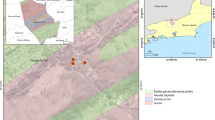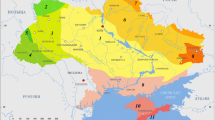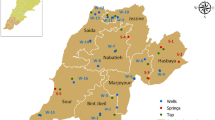Abstract
Activity concentration of 238U, 234U, 226Ra, 228Ra, 210Pb and 210Po in tap water from selected springs and private wells in the area of the former uranium mine at Žirovski Vrh were determined. A total of 22 tap water samples were collected at consumer’s houses. The results show that the activity concentrations of uranium in water samples are in range (0.17–372) and (0.22–362) mBq L−1 for 238U and 234U, respectively. Radium activity concentrations are in range (0.14–16.7) and (0.9–11.7) mBq L−1 for 226Ra and 228Ra, respectively. 210Po activity concentration is in range (0.28–8.0) mBq L−1 and can be regarded as the lowest amongst all analysed radionuclides. The range for 210Pb is (0.5–24.6) mBq L−1. Based on the results obtained for activity concentrations of six radionuclides, the committed effective dose for three different age groups of population were estimated. It was found that the committed effective dose was well below the recommended value of 100 μSv year−1, ranging from 2.3 to 34.3 μSv year−1 for adults, from 3.5 to 32.0 μSv year−1 for children (7–12 years) and from 3.0 to 23.3 μSv year−1 for infants.





Similar content being viewed by others
References
Beyermann M, Bunger T, Schmidt K, Obrikat D (2010) Occurrence of natural radioactivity in public water supplies in Germany: 238U, 234U, 235U, 228Ra, 226Ra, 222Rn, 210Pb, 210Po and gross α activity concentrations. Radiat Prot Dosim 141:72–81
Benedik L (2013) An overview of results obtained in intercomparison exercises for determination of actinides. Appl Radiat Isotop 81:10–13
Benedik L, Klemenčič H, Repinc U, Vreček P (2003) Uranium and its decay products in samples contaminated with uranium mine and mill waste. J Phys IV France 107:147–150
Benedik L, Jeran Z (2012) Radiological of natural and mineral drinking waters in Slovenia. Radiat Prot Dosim 141:72–81
Benedik L, Vasile M, Spasova Y, Wätjen U (2009) Sequential determination of 210Po and uranium radioisotopes in drinking water by alpha-particle spectrometry. Appl Radiat Isotop 67:770–775
Byrne AR, Benedik L (1988) Determination of uranium at trace levels by radiochemical neutron-activation activation analysis employing radiochemical yield evaluation. Talanta 35:161–166
Cevik U, Damla N, Karahan G, Celebi N, Kobya AI (2006) Natural radioactivity in tap waters of eastern Black Sea region of Turkey. Radiat Prot Dosim 118:88–92
Currie LA (1968) Limits for qualitative detection and quantitative determination, application to radiochemistry. Anal Chem 40:586–593
Eichrom (2001) Analytical procedures-uranium and thorium in water-ACW03. Ver 1.7. Analytical Procedures, Eichrom Technologies, Inc
EU (2013) European Union Council directive 2013/51/EURATOM of 22 October 2013 laying down requirements for the protection of the health of the general public with regard to radioactive substances in water intended for human consumption. OJ L296/12 (7.11.2013)
Hindman FD (1983) Neodymium fluoride mounting for alpha spectrometric determination of uranium, plutonium and americium. Anal Chem 55:2460–2461
Horwitz EP, Chiarizia R, Dietz ML, Diamond H (1993) Separation and preconcentration of actinides from acidic media by extraction chromatography. Anal Chim Acta 281:361–372
HyperLab (2005) System, installation and quick start guide. HyperLabs Software, Budapest, Hungary
IAEA (1996) International basic safety standards for protection against ionizing radiation and for the safety of radiation sources. Safety Report Series, No. 115, International Atomic Energy Agency, Vienna
ISO (2006) Standard ISO 5667-5: Water quality—sampling—part 5: guidance on sampling of drinking water from treatment works and piped distribution systems. International Organization for Standardization, Geneva
Jia G, Torri G, Magro L (2009) Concentrations of 238U, 234U, 235U, 232Th, 230Th, 228Th, 226Ra, 228Ra, 224Ra, 210Po, 210Pb and 212Pb in drinking water in Italy: reconciling safety standards based on measurements of gross α and β. J Environ Radioact 100:941–949
Jobbagy V, Kavasi N, Somlai J, Dombovari P, Kardos R, Kovacs T (2010) Radioanalytical investigations of uranium concentrations in natural spring, mineral, spa and drinking waters in Hungary. J Radioanal Nucl Chem 286:417–422
Kobal I, Kristan J, Škofljanec M, Jerančič S, Ančik M (1978) Radioactivity of spring and surface waters in the region of the uranium ore deposit at Žirovski vrh. J Radioanal Chem 44:307–315
Lozano JC, Fernandez F, Gomez JMG (1997) Determination of radium isotopes by BaSO4 coprecipitation for the preparation of α-spectrometric sources. J Radioanal Nucl Chem 223:133–137
Minczewski J, Chwastowska J, Dybczynski R (1982) Separation and preconcentration methods in inorganic trace analysis. John Wiley and Sons, Inc., New York
Rožmarić M, Rogić M, Benedik L, Štrok M (2012) Natural radionuclides in bottled drinking waters produced in Croatia and their contribution to radiation dose. Sci Tot Environ 437:53–60
Rožmarić M, Rogić M, Benedik L, Barišić D, Planinšek P (2014) Radiological characterization of tap waters in Croatia and the age dependent dose assessment. Chemosphere 111:272–277
Sill CW, Williams RL (1981) Preparation of actinides for alpha spectrometry without electrodeposition. Anal Chem 53:415–421
Skaberne D (2002) Facies, development and interpretation of sedimentary environment of the uranium-bearing Brebovnica Member of the Val Gardena Formation in the Žirovski vrh area, W Slovenia. Geologija 45:163–188 (in Slovene)
Skwarzec B, Struminska DI, Borylo A (2001) The radionuclides 234U, 238U and 210Po in drinking water in Gdansk agglomeration (Poland). J Radioanal Nucl Chem 250:315–318
Trajanova M, Gantar I (2005) Landslide Boršt, geological factors. Geološki zbornik 18:124–125 (in Slovene)
United Nations Scientific Committee on the Effects of Atomic Radiation UNSCEAR (2000) Report to the general assembly, with scientific annexes, vol. I. Sources and effects of ionizing radiation
Vajda N, La Rosa J, Zeisler R, Danesi P, Kis-Benedek GY (1997) A novel technique for the simultaneous determination of 210Pb and 210Po using a crown ether. J Environ Radioactivity 37:355–372
Vreček P, Benedik L, Repinc U, Stegnar P, Gantar, I (2002) Radionuclides in underground water in an area contaminated with uranium mill waste. In Uranium in the aquatic environment, 85-92. Springer Berlin Heidelberg
Wallner G, Steininger G (2007) Radium isotopes and 222Rn in Austrian drinking waters. J Radioanal Nucl Chem 274:511–516
World Health Organization WHO (1998) Guidelines for drinking-water quality: health criteria and other supporting information, second edition, Vol. 2, Geneva, Switzerland
World Health Organization WHO (2004) Guidelines for drinking water quality, recommendation, third edition, Vol. 1, Geneva, Switzerland
World Health Organisation WHO (2011) Guidelines for drinking water quality, http://www.who.int/water_sanitation_health/publications/2011/dwq_chapters/en/ 4th edition, Geneva, Switzerland.
Wrenn ME, Durbin PW, Howard B, Lipsztein J, Rundo J, Still ET, Willis DL (1985) Metabolism of ingested U and Ra. Health Phys 48:601–633
Acknowledgments
This work was financially supported by Ministry of Education, Science and Sport of Slovenia (Project P1-0143). We acknowledge the assistance of the Žirovski Vrh uranium mine in the sampling.
Compliance with ethical standards
All authors declare that this work is original. The presented research does not involve human participants and/or animals. All authors read the manuscript and agreed with the publishing.
Conflict of interest
All authors declare that there is no conflict of interest.
Author information
Authors and Affiliations
Corresponding author
Additional information
Responsible editor: Stuart Simpson
Rights and permissions
About this article
Cite this article
Benedik, L., Rovan, L., Klemenčič, H. et al. Natural radioactivity in tap waters from the private wells in the surroundings of the former Žirovski Vrh uranium mine and the age-dependent dose assessment. Environ Sci Pollut Res 22, 12062–12072 (2015). https://doi.org/10.1007/s11356-015-4481-z
Received:
Accepted:
Published:
Issue Date:
DOI: https://doi.org/10.1007/s11356-015-4481-z




